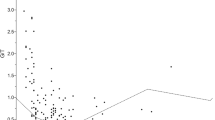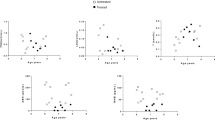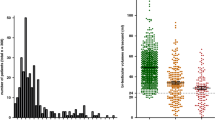Abstract
This long-term prospective follow-up study showed that in cryptorchid patients a significant correlation exists between the number of germ cells at the time of orchiopexy (prepuberty) and the spermiogram, and thus a biopsy has a prognostic value. Fifty percent of our patients had a germ cell count of <0.1 per tubule and belong to the risk group for sterility. Successful surgery could not induce a significant increase of germ cells in the risk group, although it does prevent secondary testicular damage. Patients with cryptorchidism developed after birth have significantly better chances of fertility than those with primary cryptorchidism. The priming effect of testosterone in the first months of life is important for male fertility. In patients belonging to the risk group treated with buserelin, a significant age-dependent increase in germ cell count occurred.
Similar content being viewed by others
References
Atwell JD (1985) Ascent of the testis: fact or fiction? Br J Urol 57:474–477
Canlorbe P, Toublanc JE, Roger M, Job JC (1974) Etude de la fonction endocrine dans 125 cas de cryptorchidies. Ann Endocrinol (Paris) 35:177–181
Charny CW, Wologin W (1957) Cryptorchidism. Hoeber, Philadelphia
Hadziselimovic F (1977) Cryptorchidism: ultrastructure of normal and cryptorchid testis development. Springer, Berlin Heidelberg New York
Hadziselimovic F (1983) Cryptorchidism: management and implications. Springer, Berlin Heidelberg New York
Hadziselimovic F, Seguchi H (1973) Elektronemikroskopische Untersuchungen an Kinderhoden bei unvollständigem Descensus. Acta Anat (Basel) 86:474–483
Hadziselimovic F, Hecker E, Herzog B (1984) The value of testicular biopsy in cryptorchidism. Urol Res 12:171–174
Hadziselimovic F, Hoecht B, Herzog B, Girard J (1984) Does long-term treatment with buserelin improve the fertility chances of cryptorchid testes? In: Labrie F, Belenger A, Dupont A (eds) LHRH and its analogues. Elsevier, Amsterdam, pp 488–503
Hadziselimovic F, Girard J, Herzog B (1985) Der Kryptorchismus. Ther Umsch 42:138–143
Hadziselimovic F, Thommen L, Girard J, Herzog B (1986) The significance of postnatal gonadotropin surge for testicular development in normal and cryptorchids testes. J Urol 136:274–276
Privat V (1978) Der sekundäre Hodenhochstand. Pädiatr Praxis 20:377–379
Sizonenko CP, Schindler AM, Cuendet A (1981) Clinical evaluation and management of testicular disorders before puberty. In: Burger H, de Kretser D (eds) The testis, Raven Press, New York, pp 303–328
Author information
Authors and Affiliations
Rights and permissions
About this article
Cite this article
Hadziselimovic, F., Herzog, B., Höcht, B. et al. Screening for cryptorchid boys risking sterility and results of long-term buserelin treatment after successful orchiopexy. Eur J Pediatr 146 (Suppl 2), S59–S62 (1987). https://doi.org/10.1007/BF00452877
Issue Date:
DOI: https://doi.org/10.1007/BF00452877




